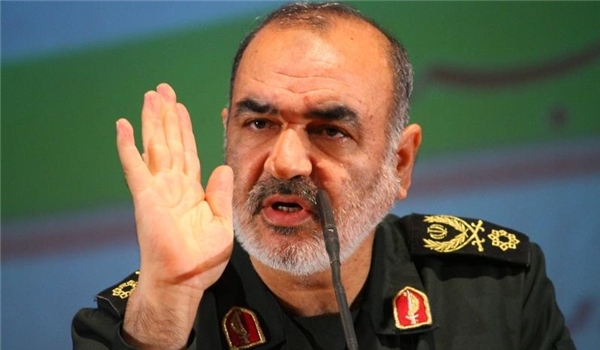 TEHRAN (FNA)- Iran knows well from which country and which base the Israeli drone that it shot down a few days ago had taken off, Lieutenant Commander of the Islamic Revolution Guards Corps (IRGC) Brigadier General Hossein Salami said.
TEHRAN (FNA)- Iran knows well from which country and which base the Israeli drone that it shot down a few days ago had taken off, Lieutenant Commander of the Islamic Revolution Guards Corps (IRGC) Brigadier General Hossein Salami said.
"What some people say that the drone had started its flight from Israel is not correct and we are almost certain about its origin, yet we would like to reserve judgment at present," Salami told reporters in Tehran on Tuesday.
He further pointed out that the drone had been traced as soon as it cross Iran's borders, bot "it was allowed to enter the country to see the intention (of the hostile forces operating it) and then we targeted and hit it at the right time".
Asked if Iran would reverse engineer the aircraft to start its production, Salami said that Iran doesn’t need to do so "although we have the power to do so", implying that technology of the Israeli drone, which was a Hermes model, does not have anything new to Iran.
The IRGC Aerospace Force shot down an Israeli spy drone before it could reach Natanz nuclear enrichment facility, in Central Iran, on Sunday.
The IRGC Public Relations Department said in a statement that the Israeli pilotless aircraft was a radar-evading, stealth drone with the mission to spy on Iran's enrichment activities by flying over Natanz nuclear enrichment plant.
The IRGC also pointed out in its statement that the Israeli hostile aircraft has been targeted by a surface-to-air missile.
Commander of the IRGC Aerospace Force Brigadier General Amir Ali Hajizadeh announced on Monday that "the downed spy drone is Hermes and made in Israel".
He said the operational range of Hermes drones is 800 kilometers, adding that the aircraft can fly 1,600 kilometers by refueling once.
The General said parts of the aircraft have burnt out after it was targeted by the ground-to-air missiles of the IRGC Aerospace Force and after its fuel tank blast, yet "some parts of this drone are intact and we are now analyzing the information and intel of these parts".
Elaborating on the details of the down Israeli aircraft, the commander further stated that the drone, which is 5.5 meters wide in wings, is equipped with two cameras which can take high-quality photos.
"There was no prior information available about the aircraft and the only one of this type had been downed in Syria, but this one is more advanced," General Hajizadeh said.
The Elbit Systems Hermes 450 is an Israeli medium size multi-payload UAV, designed for tactical long endurance missions.
It has a flight endurance of over 20 hours, with a primary mission of reconnaissance, surveillance and communications relay.
Senior IRGC officials announced on Sunday night that IRGC experts are extracting information from those parts of the plane that have remained intact.Director of the IRGC's Public Relations Department General Ramezan Sharif told FNA on Sunday night that some of the parts of the downed aircraft are working, "and our experts are studying the information and intelligence of these parts".
"We are now analyzing the information of this plane," he added.
The IRGC has warned that it "reserves the right of response and retaliation for itself".Gen. Hajizadeh as well as Basij Commander Brigadier General Mohammad Reza Naqdi have underlined that Iran would speed up arming the West Bank in retaliation to the Israeli aggression, although they have warned that this would not be Iran's only response.
Last night, Iranian Foreign Ministry Spokeswoman Marziyeh Afkham strongly condemned Israel's hostile move as a violation of Iran's territorial integrity and sovereignty, and said "We...pursue the issue at legal and international bodies... within the framework of international regulations."
By Fars News Agency
The Iran Project is not responsible for the content of quoted articles.

 QR code
QR code